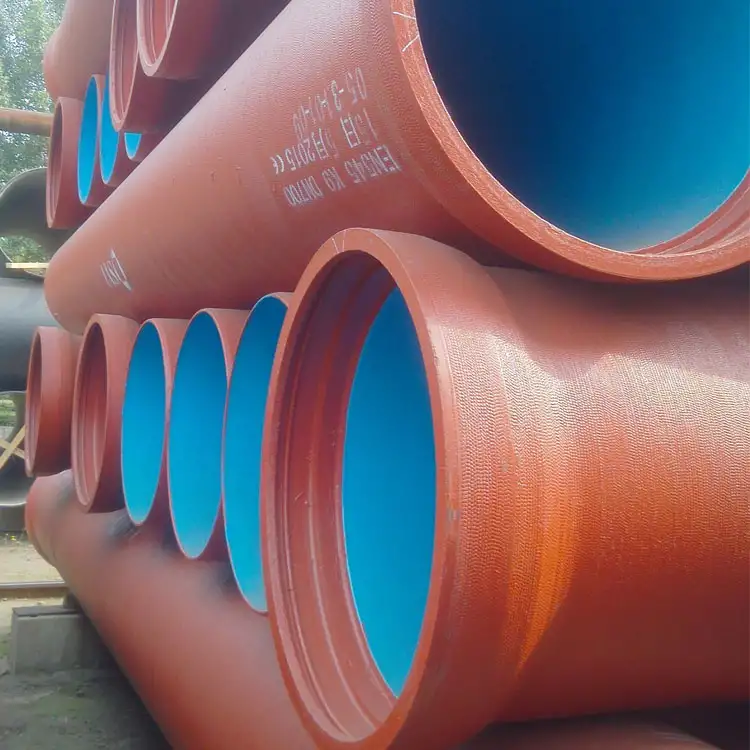The price of ductile iron pipes in China varies based on diameter, wall thickness, and regional demand, with average rates ranging from 800 to 1,500 per ton in 2025. Leading manufacturers like LuoKaiWei Ductile Iron Pipes offer competitive pricing driven by economies of scale, raw material costs (e.g., iron ore and scrap metal prices), and compliance with international standards like ISO 2531. Recent infrastructure expansions in water supply and municipal projects, alongside export tariffs and logistics costs, further influence pricing.

1. Factors Influencing Ductile Iron Pipe Prices
Several factors contribute to the pricing of ductile iron pipes:
-
Raw Material Costs: The price of iron ore and other raw materials directly affects production costs.
-
Manufacturing Processes: Advanced technologies and quality control measures can increase production costs.
-
Coating and Lining: The type of internal and external coatings (e.g., cement mortar, epoxy) influences the final price.
-
Pipe Specifications: Diameter, pressure class, and length of the pipe play a significant role in pricing.
-
Transportation and Logistics: Shipping costs, especially for international buyers, can add to the overall expense.
-
Market Demand and Supply: Fluctuations in demand and supply dynamics impact pricing strategies.
2. Regional Price Variations in China
Prices for ductile iron pipes can vary across different regions in China due to local economic conditions, production capacities, and transportation costs. For instance:
-
Northeast China: Prices range from ¥4,000 to ¥5,000 per ton for standard specifications.
-
Shandong Province: Known for competitive pricing, with rates between ¥3,800 and ¥4,500 per ton.
-
Jiangsu and Zhejiang: Higher-end pricing due to advanced manufacturing capabilities, ranging from ¥4,500 to ¥6,000 per ton.
3. Price Comparison by Pipe Specifications
The following table provides a comparative analysis of prices based on different pipe specifications:
| Specification | Diameter (mm) | Pressure Class | Price (USD/ton) |
|---|---|---|---|
| K9 C25 | 100 | PN16 | $700 – $760 |
| K9 C30 | 150 | PN16 | $750 – $800 |
| K9 C40 | 200 | PN16 | $800 – $850 |
| K9 C25 | 250 | PN16 | $850 – $900 |
| K9 C30 | 300 | PN16 | $900 – $950 |
Note: Prices are indicative and may vary based on order volume and supplier.
4. Market Trends and Forecast for 2025
The ductile iron pipe market in China is projected to experience steady growth in 2025. Factors contributing to this trend include:
-
Infrastructure Development: Ongoing urbanization and infrastructure projects drive demand.
-
Export Opportunities: Increased exports to emerging markets bolster production.
-
Technological Advancements: Adoption of efficient manufacturing processes reduces costs.
Forecasts suggest a moderate increase in prices, with an estimated growth rate of 3-5% over the next year.
5. Impact of Global Supply Chain on Prices
Global supply chain disruptions have had a significant impact on ductile iron pipe prices. Factors such as:
-
Raw Material Shortages: Limited availability of key materials increases costs.
-
Shipping Delays: Extended lead times for international shipments affect pricing.
-
Trade Policies: Tariffs and trade restrictions influence import and export costs.
These factors contribute to price volatility and necessitate strategic planning for procurement.
6. Quality Standards and Certifications
Ensuring the quality of ductile iron pipes is paramount. Adherence to international standards and certifications guarantees product reliability:
-
ISO 2531: Specifies requirements for ductile iron pipes for water and sewage systems.
-
EN 545: European standard for ductile iron pipes for water pipelines.
-
EN 598: European standard for ductile iron pipes for sewerage applications.
-
ISO 9001: Quality management systems certification.
Compliance with these standards ensures the production of high-quality, durable pipes.
7. Frequently Asked Questions (FAQs)
Q1: What is the average price of ductile iron pipes in China for 2025?
The average price ranges from $700 to $950 per ton, depending on specifications and regional factors.
Q2: How do coating types affect the price of ductile iron pipes?
Different coatings, such as cement mortar or epoxy, add to the production cost due to materials and application processes.
Q3: Are there significant price differences between domestic and export ductile iron pipes?
Yes, export pipes often incur additional costs due to shipping, tariffs, and compliance with international standards.
Q4: How does the diameter of the pipe influence its price?
Larger diameter pipes require more raw materials and labor, leading to higher prices.
Q5: What is the impact of pressure class on pricing?
Higher pressure classes necessitate stronger materials and more rigorous testing, increasing the overall cost.
Q6: How can buyers mitigate price fluctuations in the ductile iron pipe market?
Engaging in long-term contracts, bulk purchasing, and sourcing from multiple suppliers can help stabilize costs.
9. Conclusion
Understanding the pricing dynamics of ductile iron pipes in China for 2025 is essential for stakeholders in the construction and infrastructure sectors. By considering factors such as raw material costs, manufacturing processes, and regional variations, buyers can make informed decisions to optimize procurement strategies.
